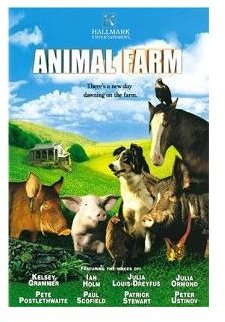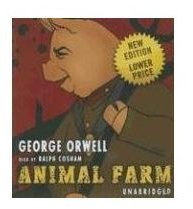Animal Farm Movie vs. Animal Farm Book: What Changes Has the Film Made?


I recently showed the 1999 TV movie version of Animal Farm to my freshman English class after we finished reading the book. I chose this version over the 1954 cartoon version because the live-action animals seemed to resonate more strongly with my students, who laughed at the 50’s-style animation when we watched clips from the older film.
No film adaptation of a written work is ever perfect, but I did expect this one to be fairly accurate. Animal Farm is a rather short book, after all. For the most part, I feel like this movie does a great job capturing the essence of Orwell’s work, but there are some significant departures that both teachers and students should be aware of.
Timeline
The book progresses in a linear fashion. It moves forward chronologically from beginning to end. The filmmakers, however, chose to start the narrative years after the events of the book and situate the entire film as a flashback.
This decision to mess with the timeline affects the overall tone of the film in several ways. In the book, things become steadily worse as the book progresses, with no relief in sight. This forces the reader to feel and sympathize with the plight and hopelessness of the animals. The ending of the book, which sees Napoleon and his fellow pigs effectively transformed into human beings, is the culmination of this progression.
It’s the absolute worst possible thing that could happen to the animals on the farm, and the book ends abruptly afterward, leaving the reader feeling frustrated and angry, which is the appropriate response to the events in the narrative.
The film takes a different perspective, one which radically affects the viewer’s impression following the film. It begins with a group of animals returning to the farm after the fall of Napoleon’s empire. These animals went into hiding following the betrayal of Boxer, and are only now returning to see what’s become of their beloved animal farm.
Knowing that there are animals who survive the events on the farm effectively hamstrings the tension of the film’s events. Sure, the viewer is still frustrated with Napoleon’s actions, but they aren’t as dramatic when you know all along that he’ll eventually fall from power and that a group of animals will ultimately survive.
This change in timeline and addition of extra events not found in the book injects something which Orwell purposely excluded from his novel: hope. The ending in the book is depressing, yes, but it’s also effective. Changing it just to appeal to a broader audience is a disservice to the ideals of the author.
Perspective
The book is narrated from a specific perspective. Basically, the reader sees what the animals see and is told what the animals are told. We are given no insight into what the pigs are up to beyond what is observed by the other animals on the farm. The only explanations we receive from them are the ones that Squealer provides, we are left to decide how truthful his words are.
In the film, we are privy to Napoleon’s scheming from the very beginning. We see him planning to steal the puppies and raise them on his own, we hear him say one thing and then urge Squealer to say another, and we can observe his every interaction with Mr. Pilkington (standing in for Mr. Whymper, another significant change in the film).
This change in perspective shifts the viewer of the film into the role of outside observer. Instead of feeling the sting of injustice and suspicion about Napoleon’s true intentions alongside the animals on the farm, we’re merely watching as evil deeds are being done and lies are being told to others. The film leaves little room for doubt about Napoleon’s motivation, the book forces the reader to look at the evidence and draw their own conclusions.
Napoleon’s Filmmaking
Easily the most absurd addition to the film version is Napoleon’s propaganda filmmaking. When Squealer and company manage to basically set up a fully functioning film studio on the farm, using “some of Jones’ old camera equipment,” willful suspension of disbelief goes right out the window (even in a film filled with talking animals).
I get it, film is supposed to be a visual medium, but it’s a little ridiculous when the filmmakers want us to believe that Squealer spends hours crafting films featuring voiceover work, choreographed fowl flyovers and a complicated ever-widening shot of the farm from above that could only be achieved in modern times through use of a helicopter. Even more ridiculous is the fact that he goes to all this trouble to produce high-quality propaganda films and we only ever see a handful of animals watching them.
Tweaking the perspective and adding to the ending are minor, but acceptable changes. Watching the camera dramatically pan up to reveal a fully suited Napoleon standing on his hind legs while regiments of chanting ducks march in front of him completely changes the tone of the story. This shot is so ridiculous it’s laughable. I get that the intention is to create a more concrete connection between Napoleon and Stalin, but the spectacle is so far out of the reach of the animals on the farm (who could barely cobble together the world’s worst excuse for a windmill) it’s ridiculous.
I point out these differences not to convince teachers that they shouldn’t use this film, (I still think it’s the best adaptation of the book) but rather to make them aware of some significant issues which students should probably know about. The last thing we want is students writing about how Napoleon made a bunch of movies before he was overthrown and new human owners arrived at the end of the book.
There are some great moments in this film, but it is far from a “true to the book” adaptation of Orwell’s classic.
References
All references from author’s experience.
Photos courtesy of Amazon